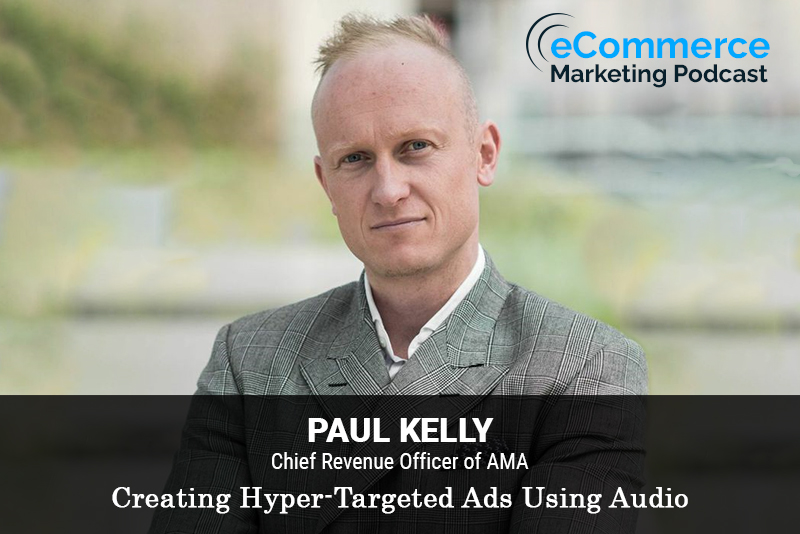
The eCommerce Marketing Podcast walks you through everything that goes into ecommerce marketing — from inbound marketing to paid advertising to conversions. Learn the strategies top marketing experts use to grow their businesses.
Paul Kelly is the chief revenue officer of A Million Ads, a leading firm specializing in dynamic audio ads for hundreds of brands, like Target, Under Armour and Ford. His role allows him to speak to brands daily and manage a new era of personalization in audio that is both privacy compliant yet still capable of meeting the individual customer’s needs. Prior to A Million Ads, Paul shaped and actively scaled the commercial strategy for a number of high-growth digital companies including Viacom, AwesomenessTV, Watchmojo and GoldieBlox. His experiences gave him first-hand knowledge about brand activity outside above the line advertising, including advanced customer service and product development.
In this episode, you will learn
How has the rise of podcasting and streaming services influenced the growing importance of audio advertising in the ecommerce marketing world
The concept of hyper-targeting in the context of audio ads and how it can lead to significant cost savings for businesses
What sets audio ads apart from traditional advertising mediums when it comes to personalization and audience targeting
Key elements that make an audio ad campaign successful and memorable for listeners
Example of a brands that have seen significant success by leveraging hyper-targeted audio ads
For show transcript and past guests, please visit https://www.ecommercemarketingpodcast.com
Or on YouTube at:
https://www.youtube.com/channel/UC3PgT0NOGzpdPGQtBK0XLIQ
Follow Arlen:
Twitter: https://twitter.com/askarlen
Facebook: https://www.facebook.com/arlen.robinson.7
Instagram: https://www.instagram.com/arlenyohance/
LinkedIn: https://www.linkedin.com/in/arlenrobinson/
Past guests on the ecommerce marketing podcast include Neil Patel, Nemo Chu, Luke Lintz, Luke Carthy, Amber Armstrong, Kris Ruby and many more.
Thanks for listening. Be sure to subscribe and leave a review.

Title: Hyper-Targeting Audio Ads for Maximum Impact with Paul Kelly
Guest: Paul Kelly, Chief Revenue Officer of A Million Ads
Host: Arlen Robinson
In this episode of the eCommerce Marketing Podcast, Arlen Robinson interviews Paul Kelly, the Chief Revenue Officer of A Million Ads, a leading firm specializing in dynamic audio ads. Paul shares insights on how A Million Ads leverages dynamic audio advertising to hyper-target audiences and optimize ad spending effectively.
Key Takeaways:
- [00:03:12] Revolutionary Dynamic Audio Advertising:
- A Million Ads uses a cloud-based ad server to infer contextual information such as a listener’s location, device type, and time to deliver optimal brand messages in real time.
- [00:05:20] Impact of Podcasts and Streaming Services:
- The rise of podcasts and streaming services has increased the importance of audio advertising. Audio creates new units of time for engagement, allowing advertisers to reach audiences during activities like commuting or exercising.
- [00:09:53] Hyper-Targeting and Cost Savings:
- Hyper-targeting in audio ads involves leveraging advanced audience segments and proxy information to create robust clusters for ad targeting. This approach is privacy-compliant and effective in reaching the right audience without excessive costs.
- [00:15:13] Individual Customer Data:
- Utilizing first-party data allows brands to tailor ads to individual customers based on their status, preferences, and behavior. For example, existing customers might receive upgrade offers, while potential customers get enticing promotions.
- [00:18:24] Effective Ad Content:
- The type of content that performs best depends on the size and niche of the e-commerce brand. Large brands benefit from personalized ads catering to diverse customer needs, while niche brands should map their content to specific genres and interests of their audience.
- [00:24:21] Case Study – Target:
- Target uses A Million Ads to create hyper-current and location-specific audio ads. This system allows them to update ads weekly, ensuring relevancy and timeliness, which is crucial for their numerous stores and ever-changing promotions.
Guest Info:
- Paul Kelly
- Chief Revenue Officer of A Million Ads
- Website: A Million Ads











